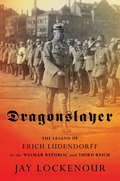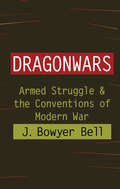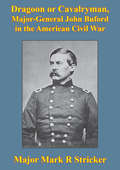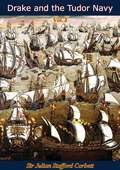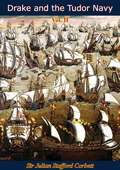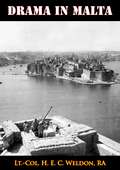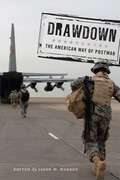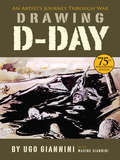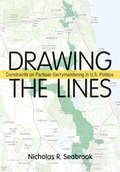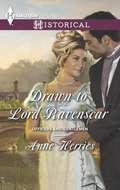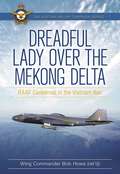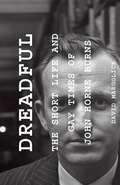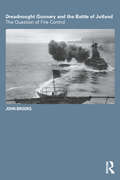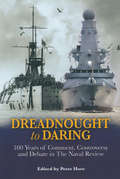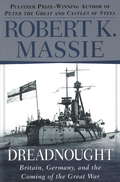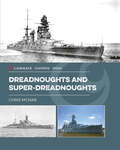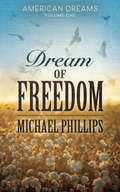- Table View
- List View
Dragonslayer: The Legend of Erich Ludendorff in the Weimar Republic and Third Reich (Battlegrounds: Cornell Studies in Military History)
by Jay LockenourIn this fascinating biography of the infamous ideologue Erich Ludendorff, Jay Lockenour complicates the classic depiction of this German World War I hero. Erich Ludendorff created for himself a persona that secured his place as one of the most prominent (and despicable) Germans of the twentieth century. With boundless energy and an obsession with detail, Ludendorff ascended to power and solidified a stable, public position among Germany's most influential. Between 1914 and his death in 1937, he was a war hero, a dictator, a right-wing activist, a failed putschist, a presidential candidate, a publisher, and a would-be prophet. He guided Germany's effort in the Great War between 1916 and 1918 and, importantly, set the tone for a politics of victimhood and revenge in the postwar era. Dragonslayer explores Ludendorff's life after 1918, arguing that the strange or unhinged personal traits most historians attribute to mental collapse were, in fact, integral to Ludendorff's political strategy. Lockenour asserts that Ludendorff patterned himself, sometimes consciously and sometimes unconsciously, on the dragonslayer of Germanic mythology, Siegfried—hero of the epic poem The Niebelungenlied and much admired by German nationalists. The symbolic power of this myth allowed Ludendorff to embody many Germans' fantasies of revenge after their defeat in 1918, keeping him relevant to political discourse despite his failure to hold high office or cultivate a mass following after World War I.Lockenour reveals the influence that Ludendorff's postwar career had on Germany's political culture and radical right during this tumultuous era. Dragonslayer is a tale as fabulist as fiction.
Dragonwars: Armed Struggle and the Conventions of Modern War
by J. Bowyer BellFor centuries international order has been troubled by small wars, insurrections, and revolts--low intensity conflicts. With the implosion of the Soviet empire many thought such violence could be eradicated through the growth of democracy, open societies, and increased productivity and education. Instead the world remains filled with turmoil, pogroms, famine, civil war, rebellion, and terror, often instigated by armed and dangerous zealots. To Americans such killers seem alien and inexplicable, fanatics without reason, beyond the reach of conventional containment or retaliation. J. Bowyer Bell here explores the psychological and strategic ecosystems (which he terms dragon worlds) of modern political violence and suggests how America might effectively deal with it.Dragonwars combines analysis with historical examples drawn from America's involvement with armed struggle in Lebanon, Central Am-erica, Greece, and Vietnam. In each instance, Bell argues, American policy was flawed by lack of empathy and historical understanding combined with a belief that failure could be traced to mistakes in details and procedures. The break up of the old bipolar U.S.-Soviet confrontation released suppressed ambitions, tribal greed, and greater flexibility for the small player. With new technologies of terror, zones of security will become smaller, since open societies present attractive targets for zealots. Bell rejects the notion that massive force can effect a swift and final result. Instead, a new type of warrior will be required; one versed in history and empathetic to the belief-systems of the dragonworlds in which they are deployed.Bell acknowledges that his proposals run counter to American belief and practice, but argues that in the face of insoluble conflicts, incremental advantages, through limited altered global arena, Dragonwars will prove an indispensable guide for policymakers, military planners, historians, and political scientists.
Dragoon Or Cavalryman, Major General John Buford In The American Civil War [Illustrated Edition]
by Major Mark R. StrickerIncludes more than 25 maps and illustrationsThis study investigates the American Civil War role and contributions of Major General John Buford. Buford, a 1848 graduate of the United States Military Academy, began his Army career on America's frontier with the First United States Dragoons. With the outbreak of the Civil War, Buford was selected to command a cavalry brigade in John Pope's Army of Virginia, and participated in the Second Manassas Campaign. Buford went on to make significant contributions to the Union efforts in the Eastern Theater; however, history has generally portrayed Buford as a one-dimensional character based on his stand along McPherson and Seminary Ridges on the first day of the Battle of Gettysburg. Several historians have presumed that the dismounted cavalry (or Dragoon) tactics used by Buford at Gettysburg were the culmination of a method of fighting which he helped develop and propagate within the Union cavalry. However, this thesis shows that contrary to this Dragoon image, Buford was in fact a remarkable cavalry officer. His battlefield tactics were fairly traditional, but it was not in pitched battles that Buford excelled. His significant contributions were in the established roles of cavalry; performing reconnaissance and providing security for the army he was supporting.
Drake and the Tudor Navy Vol. I (Drake and the Tudor Navy #1)
by Sir Julian Stafford CorbettTHE NAVAL ART IN THE MIDDLE OF THE SIXTEENTH CENTURYTHE conspicuous technical feature of the maritime revolution which in the sixteenth century transferred the focus of the naval art from the Mediterranean to the Atlantic is the transition from galley warfare to warfare under sail; and the history of that transition, of its causes, its development, and its results, is the history of the rise of the English naval supremacy.The whole of maritime warfare falls naturally into three periods, each sharply characterised by a generic difference in the ‘capital ship,’ as in the seventeenth century it was happily called—the ship, that is, which formed the backbone of a fighting fleet and which had a place in the fighting line. The first period is that of the galley, beginning in prehistoric times and culminating in the year 1571, at the battle of Lepanto; the second is that of the ‘great ship,’ or ‘ship of the line,’ which was established in 1588 with the campaign of the Great Armada, and reached its highest development at Trafalgar; the third is that in which we now live, the period of the ‘battleship.’ Or, to state the classification in terms of its real basis, there is a period of oars, a period of sails, and a period of steam.
Drake and the Tudor Navy Vol. II (Drake and the Tudor Navy #2)
by Sir Julian Stafford CorbettTHE NAVAL ART IN THE MIDDLE OF THE SIXTEENTH CENTURYTHE conspicuous technical feature of the maritime revolution which in the sixteenth century transferred the focus of the naval art from the Mediterranean to the Atlantic is the transition from galley warfare to warfare under sail; and the history of that transition, of its causes, its development, and its results, is the history of the rise of the English naval supremacy.The whole of maritime warfare falls naturally into three periods, each sharply characterised by a generic difference in the ‘capital ship,’ as in the seventeenth century it was happily called—the ship, that is, which formed the backbone of a fighting fleet and which had a place in the fighting line. The first period is that of the galley, beginning in prehistoric times and culminating in the year 1571, at the battle of Lepanto; the second is that of the ‘great ship,’ or ‘ship of the line,’ which was established in 1588 with the campaign of the Great Armada, and reached its highest development at Trafalgar; the third is that in which we now live, the period of the ‘battleship.’ Or, to state the classification in terms of its real basis, there is a period of oars, a period of sails, and a period of steam.
Drama In Malta
by Lt.-Col. H. E. C. Weldon R.A.A fascinating personal flashback, Weldon's account of his service as an artillery officer in Malta, 1939-1943, based on notes made during 1939-1943."A great deal of this personal narrative was originally jotted down in Malta during intervals between the raids. The remainder has been added, and the whole of it revised, while "On Active Service". There lie my excuses for any inconsistencies of style the reader may remark and also for the inclusion of certain episodes to the exclusion of others of at least equal importance. So much happened during the four years I lived out there and now, apart from an invaluable page of dry official statistics, I have only my memory to rely on as a guide. So I deemed it better to make the story a personal one and to tell mainly of those matters, whether military, social or dramatic, of which I had intimate knowledge and which would also serve to give a picture of the background to our lives and battles in that isolated little fortress."At the same time I have long felt that there should be wider knowledge of the part that was played by the Army in Malta and in particular by the Royal Regiment of Artillery and its brother in arms, the Royal Malta Artillery. It was by these men, without hope or relief or rest, that the constant strain of three years of bombing, isolation and blockade was borne. The epics of naval heroism that ensured the provisioning of Malta and the doughty deeds of the Royal Air Force in its defence are justly renowned through the press and official publications alike. This pen of mine is a very inadequate instrument with which to describe the contribution of the Army as a whole at its true worth. The back-breaking jobs, the constant vigils and spirited defence of those magnificent battalions of Infantry need a scribe of their own. Suffice it for me to say that the names of Hal Far and the Devons, Luqa and the West Kents, Ta Kali and the Manchesters, Safi and the Hampshires, the Dockyard and the Cheshires, to mention only some, will forever be indissolubly linked in glory and friendship."But over half of the garrison were "gunners"--English and Maltese--and it is because I am immensely proud of having had the privilege both of serving in Malta during those stirring times and of being a humble member of the Royal Regiment of Artillery that these pages are written in honour of:"The Gunners in Malta, 1940--1943."
Dramaturgies of War: Institutional Dramaturgy, Politics, and Conflict in 20th-Century Germany
by Anselm Heinrich Ann-Christine SimkeThis book examines the institutional contexts of dramaturgical practices in the changing political landscape of 20th century Germany. Through wide-ranging case studies, it discusses the way in which operationalised modes of action, legal frameworks and an established profession have shaped dramaturgical practice and thus links to current debates around the “institutional turn” in theatre and performance studies. German theatre represents a rich and well-chosen field as it is here where the role of the dramaturg was first created and where dramaturgy played a significantly politicised role in the changing political systems of the 20th century. The volume represents an important addition to a growing field of work on dramaturgy by contributing to a historical contextualisation of current practice. In doing so, it understands dramaturgy not only as a process which occurs in rehearsal rooms and writers’ studies, but one that has far wider institutional and political implications.
Drawdown: The American Way of Postwar (Warfare and Culture #8)
by Jason W. WarrenAnalyzes the cultural attitudes, political decisions, and institutions surrounding the maintenance of armed forces throughout American history While traditionally, Americans view expensive military structure as a poor investment and a threat to liberty, they also require a guarantee of that very freedom, necessitating the employment of armed forces. Beginning with the seventeenth-century wars of the English colonies, Americans typically increased their military capabilities at the beginning of conflicts only to decrease them at the apparent conclusion of hostilities. In Drawdown: The American Way of Postwar, a stellar team of military historians argue that the United States sometimes managed effective drawdowns, sowing the seeds of future victory that Americans eventually reaped. Yet at other times, the drawing down of military capabilities undermined our readiness and flexibility, leading to more costly wars and perhaps defeat. The political choice to reduce military capabilities is influenced by Anglo-American pecuniary decisions and traditional fears of government oppression, and it has been haphazard at best throughout American history. These two factors form the basic American “liberty dilemma,” the vexed relationship between the nation and its military apparatuses from the founding of the first colonies through to present times. With the termination of large-scale operations in Iraq and the winnowing of forces in Afghanistan, the United States military once again faces a significant drawdown in standing force structure and capabilities. The political and military debate currently raging around how best to affect this force reduction continues to lack a proper historical perspective. This volume aspires to inform this dialogue. Not a traditional military history, Drawdown analyzes cultural attitudes, political decisions, and institutions surrounding the maintenance of armed forces.
Drawing D-Day: An Artist's Journey Through War
by Ugo Giannini Maxine Giannini“Drawing D-Day powerfully and poignantly reflects back on the watershed event of the 20th century in a way that is unexpected and completely unique.” — Jeffery R. Fulgham, CFRE, Vice President, Finance and Development, National D-Day Memorial FoundationDrawing D-Day: An Artist's Journey Through War offers an extraordinary, one-of-a-kind testimony in words and images by a soldier and artist who participated in one of the most famous military operations of World War II. On June 6, 1944, Ugo Giannini landed on Omaha Beach with a platoon of military police assigned to accompany the U.S. Army's 29th Infantry Division. Only six of the thirty-seven men in the platoon made it to the beach. Told that he was needed on the bluff above the shore, Ugo climbed the Verville Draw, jumped into a crater made by naval bombardment, and spent that day and part of the next as an eyewitness to the invasion. Remarkably, he began to draw. These are the only known drawings from that historic day. Drawn in pencil and pen, in a gritty, realist style, the images depict heavily burdened infantrymen trying to stay afloat in seawater, crawling on the beach, and dead among the ruins of a bombed-out village. The illustrations, interwoven with Ugo's letters to his family and girlfriend, portray the horror of war in a deep and personal way. Abstract paintings at the end of the book, composed forty years later, make a powerful statement of the enduring power about war on an artist-soldier's psyche.
Drawing the Lines: Constraints on Partisan Gerrymandering in U.S. Politics
by Nicholas R. SeabrookRadical redistricting plans, such as that pushed through by Texas governor Rick Perry in 2003, are frequently used for partisan purposes. Perry's plan sent twenty-one Republicans (and only eleven Democrats) to Congress in the 2004 elections. Such heavy-handed tactics strike many as contrary to basic democratic principles. In Drawing the Lines, Nicholas R. Seabrook uses a combination of political science methods and legal studies insights to investigate the effects of redistricting on U.S. House elections. He concludes that partisan gerrymandering poses far less of a threat to democratic accountability than conventional wisdom would suggest.Building on a large data set of the demographics of redrawn districts and subsequent congressional elections, Seabrook looks less at the who and how of gerrymandering and considers more closely the practical effects of partisan redistricting plans. He finds that the redrawing of districts often results in no detrimental effect for district-level competition. Short-term benefits in terms of capturing seats are sometimes achieved but long-term results are uncertain. By focusing on the end results rather than on the motivations of political actors, Seabrook seeks to recast the political debate about the importance of partisanship. He supports institutionalizing metrics for competitiveness that would prove more threatening to all incumbents no matter their party affiliation.
Drawn to Lord Ravenscar
by Anne HerriesBETRAYED BY MARRIAGE When her betrothed is brutally murdered Lucy Dawlish looks for comfort from the man who shares her grief-his brother, Paul Ravenscar. Virtuous Lucy has always been secretly drawn to this frosty lord, but is it too late to reveal where her heart truly lies? Paul Ravenscar must marry and produce an heir for the sake of his estate, but there is only one woman he wants. To claim Lucy as his bride risks betraying his brother's memory, but Paul might be unable to keep his feelings hidden.... Officers and Gentlemen For duty, for honor, for love
Dreadful Lady over the Mekong Delta: RAAF Canberras in the Vietnam War
by Bob HoweDreadful Lady over the Mekong Delta looks at the men of No 2 Squadron and the operations they flew in the Vietnam War in their Canberra bombers. From April 1967, the squadron spent four years attacking enemy targets, many of them in the Mekong Delta region, and contending with the politics, weather, and &‘fog&’ of war. The riverine operations supported by No 2 Squadron were but a small part of an allied effort to disrupt the enemy&’s movement of troops and supplies to locations in South Vietnam. It was, according to one commentator, &‘a kind of guerrilla warfare conducted in a navy environment&’. Bob Howe arrived in Vietnam in 1969 as a youthful Canberra navigator/bomb-aimer, but much of his time was spent as a specialist in bombing operations. His time there provided him with the firsthand experience and detailed information to write this book. This book in its original format was first published in 2016 by the RAAF&’s Air Power Development Centre, filling a gap in the recording of the RAAF&’s operations in Vietnam. It also describes how crews overcame the difficulties of operating in an intense Asian war in an aircraft that was designed for a completely different environment. This new edition is intended to bring the experiences and exploits of Bob Howe, No 2 Squadron and its Canberra bomber aircraft to life for a new generation of reader.
Dreadful: The Short Life and Gay Times of John Horne Burns
by David MargolickAmerican author John Horne Burns (1916-1953) led a brief and controversial life, and as a writer, transformed many of his darkest experiences into literature. Burns was born in Massachusetts, graduated from Andover and Harvard, and went on to teach English at the Loomis School, a boarding school for boys in Windsor, Connecticut. During World War II, he was stationed in Africa and Italy, and worked mainly in military intelligence. His first novel, The Gallery (1947), based on his wartime experiences, is a critically acclaimed novel and one of the first to unflinchingly depict gay life in the military. The Gallery sold half a million copies upon publication, but never again would Burns receive that kind of critical or popular attention. Dreadful follows Burns, from his education at the best schools to his final years of drinking and depression in Italy. With intelligence and insight, David Margolick examines Burns's moral ambivalence toward the behavior of American soldiers stationed with him in Naples, and the scandal surrounding his second novel, Lucifer with a Book, an unflattering portrayal of his experiences at Loomis.
Dreadnought Gunnery and the Battle of Jutland: The Question of Fire Control
by John BrooksThis new book reviews critically recent studies of fire control, and describes the essentials of naval gunnery in the dreadnought era.With a foreword by Professor Andrew Lambert, it shows how, in 1913, the Admiralty rejected Arthur Pollen's Argo system for the Dreyer fire control tables. Many naval historians now believe that, consequently, Br
Dreadnought to Daring: 100 Years of Comment, Controversy and Debate in The Naval Review
by Peter HoreDreadnought to Daring is an absorbing and highly readable summary of a century of naval thinking which has been written by some of the leading lights in contemporary naval history.Founded in 1912 by some of the Royal Navys brightest officers, the quarterly Naval Review has never been subject to official censorship, and its naval members do not need official permission to write for it, so it has always provided an independent, lively and at times outspoken forum for service debate. In broad terms it has covered contemporary operations, principles of naval warfare, history, and anecdotes which record the lighter side of naval life, but sometimes with a bite to them. A correspondence section provides an important barometer of service opinion, while extensive book reviews, written by those with real knowledge of the subject, carry considerable weight. For these reasons the Naval Review is widely regarded as a journal of record.In return for its freedom, circulation is restricted to members and membership to serving or retired officers. However, this volume will give the interested public an insight into its activities, past and present. Intended both to celebrate and to analyse the impact of the journal over its 100-year history, it comprises a series of specially commissioned articles, divided chronologically and thematically, devoted to subjects that have been of importance to the naval community as reflected in the pages of the journal. It concludes with an assessment of how well the Naval Review has succeeded in its founders aim and what influence it has had on policy.
Dreadnought: Britain, Germany, and the Coming of the Great War
by Robert K. Massie"A classic [that] covers superbly a whole era...Engrossing in its glittering gallery of characters."CHICAGO SUN-TIMES. Pulitzer Prize-winning author, Robert K. Massie has written a richly textured and gripping chronicle of the personal and national rivalries that led to the twentieth century's first great arms race. Massie brings to vivid life, such historical figures as the single-minded Admiral von Tirpitz, the young, ambitious, Winston Churchill, the ruthless, sycophantic Chancellor Bernhard von Bulow, and many others. Their story, and the story of the era, filled with misunderstandings, missed opportunities, and events leading to unintended conclusions, unfolds like a Greek tragedy in his powerful narrative. Intimately human and dramatic, DREADNOUGHT is history at its most riveting.
Dreadnoughts and Super-Dreadnoughts (Casemate Illustrated Special)
by Chris McNabA heavily illustrated account of the evolution, design and deployment of dreadnought battleships.When HMS Dreadnought was commissioned into the Royal Navy in 1906 this revolutionary new class of big-gun iron-clad warship immediately changed the face of naval warfare, rendering all other battleships worldwide obsolete. The Admiralty realised that as soon as the ship was revealed to the global naval community Britain would be a in race to stay ahead, and so the first dreadnoughts were built in record time. While there were those who regarded the vessel as a triumphant revolution in naval design, the dreadnought initially had its critics, including those who thought its slower, heavier guns left it vulnerable to the secondary armament of other warships. Nevertheless, other countries, notably Germany, and the United States soon began to lay down dreadnoughts. The culmination of this arms race would be the confrontation of the British and German fleets at the Battle of Jutland in May 1916 – the greatest clash of naval firepower in history. This book gives detailed insights into the design, operation and combat history of these incredible vessels.
Dream Keeper (Dream Team #4)
by Kristen AshleySpinning off from the bestselling Dream Man and Rock Chick series, this is the emotional and steamy contemporary romance fans of the Dream Team series have been waiting for!He&’s perfect—but he can&’t be hers.Pepper Hannigan is determined to keep any romance off the table—and out of her bedroom—while her daughter Juno is still young. Sure, a certain handsome commando is thoughtful, funny, and undeniably hot, but Pepper&’s had her heart broken before, and she won&’t let it happen again. Not to her or her little girl, even if this hero could melt any woman&’s resolve.Augustus &“Auggie&” Hero can&’t deny his attraction to beautiful, warm-hearted Pepper or how much he wants to make a home with her and her little girl, but Pepper&’s mixed signals have kept him away. That is, until Juno decides to play matchmaker. Her efforts finally bring Pepper into his arms, but they expose the danger Pepper is in. To protect Pepper and Juno, Auggie will have to live up to his last name and prove happy endings aren&’t just for fairy tales.
Dream Man Box Set Books 1-4: An Anthology
by Kristen AshleyMeet the intense and sexy men of the Dream Men series from the New York Times and USA Today bestselling author of the Rock Chick Series!Mystery ManGwendolyn Kidd has met the man of her dreams. He's hot, he's sexy, and what started as a no-names-exchanged night of passion has blossomed into a year and a half-long pleasure fest. Hawk Delgado has demons that keep him from connecting with anyone. But when Gwen is threatened, Hawk's protective nature comes out in full force. The problem is, when Gwen gets a dose of Hawk's Alpha attitude in the daylight, she's not so sure he's the one anymore.Wild ManTessa O'Hara never expected the man of her dreams to walk into her bakery. Within thirty seconds he asks her out for a beer. But when she discovers he's an undercover DEA agent-and he's investigating her possible role in her ex-husband's drug business, Tess declares their relationship is over. Brock disagrees. He's committed to his mission, but he's fallen in love with the beautiful woman who's as sweet as her cupcakes-and he'll do anything to win her back.Law ManSweet, shy Mara Hanover is in love with her neighbor. For four years, she has secretly watched her dream man from afar. Handsome police detective Mitch Lawson is way out of her league. She's a girl from the wrong side of the tracks, and there's no way a guy like Mitch would want anything to do with her. But when Mara gets pulled back into the life she's tried so hard to leave behind, it's Mitch who comes to her rescue.Motorcycle ManTyra Masters has had enough drama to last a lifetime. Now she's back on track and looking forward to her new quiet life. Until she meets the man of her dreams. The tattooed, muscled biker plies her with tequila-and the best sex of her life. She knows Kane "Tack" Allen is the kind of man she's always wanted. Unfortunately, he's also her new boss . . .
Dream a Little Dream
by Rosie ArcherThe next heartwarming instalment of the Timber Girls Series. Perfect for fans of Elaine Everest and Pam Howes.Trixie and her fellow lumberjills are back in Scotland, newly stationed at the MacKay estate. When they arrive, they are shocked to find the place dilapidated and neglected and the taciturn and secretive Noah MacKay not at all happy to be meeting them.It quickly becomes apparent that MacKay was expecting men from the forestry commission to take charge, rather than four young women. Trixie, Jo, Hen and Vi decide he needs to be proven wrong - after all, don't they have stamina, skill and strength? But as the girls work to prove their worth, secrets from their own pasts threaten to follow them to Sutherland.
Dream a Little Dream
by Rosie ArcherThe next heartwarming instalment of the Timber Girls Series. Perfect for fans of Elaine Everest and Pam Howes.Trixie and her fellow lumberjills are back in Scotland, newly stationed at the MacKay estate. When they arrive, they are shocked to find the place dilapidated and neglected and the taciturn and secretive Noah MacKay not at all happy to be meeting them.It quickly becomes apparent that MacKay was expecting men from the forestry commission to take charge, rather than four young women. Trixie, Jo, Hen and Vi decide he needs to be proven wrong - after all, don't they have stamina, skill and strength? But as the girls work to prove their worth, secrets from their own pasts threaten to follow them to Sutherland.(P) 2023 Quercus Editions Limited
Dream a Little Dream: A heartwarming and utterly gripping WW2 saga
by Rosie ArcherThe next heartwarming instalment of the Timber Girls Series. Perfect for fans of Elaine Everest and Pam Howes.Trixie and her fellow lumberjills are back in Scotland, newly stationed at the MacKay estate. When they arrive, they are shocked to find the place dilapidated and neglected and the taciturn and secretive Noah MacKay not at all happy to be meeting them.It quickly becomes apparent that MacKay was expecting men from the forestry commission to take charge, rather than four young women. Trixie, Jo, Hen and Vi decide he needs to be proven wrong - after all, don't they have stamina, skill and strength? But as the girls work to prove their worth, secrets from their own pasts threaten to follow them to Sutherland.
Dream a Little Dream: A young family rediscover their roots and true happiness
by Joan JonkerAn ambitious family learns that the grass isn't always greener on the other side. Joan Jonker leaves behind Liverpool's terraces for a wealthy family home in Dream a Little Dream - a charming saga of new beginnings and old ties. Perfect for fans of Katie Flynn and Cathy Sharp.Edie Dennison was a sweet young girl when she first met her husband Robert living in the same street of two-up two-down houses in Seaforth. Now, thanks to the success of Robert's business, they've gone up in the world. When Robert realises that his wife has forgotten her roots, and is encouraging their children to have ideas above their station, he decides to take his two youngest children, Nigel and Abbie, back to Seaforth, to meet their old friends and the grandparents they never knew they had. Soon they discover a whole new world of happiness is waiting for them... What readers are saying about Dream a Little Dream: 'The observation of social niceties is absolutely spot-on, with all the humour and warmth coming from a clash between class pretension and the realities of life. Bob and Edie are brilliantly drawn, and this one will acquire new readers for the talented Jonker''Once again another superb saga by the best author in the world! I have read all Joan's books ...This book is the best yet!'
Dream of Freedom (American Dreams #1)
by Michael PhillipsThe author of the Secret of the Rose series transports readers to the South, as the seeds of Civil War are sown—and those against slavery take a stand. In the antebellum South, Richmond and Carolyn Davidson live lives of ease as wealthy plantation owners. But even though their prosperity and livelihood depend on slave ownership, their Christian consciences speak against the practice. When the Davidsons decide to follow their own moral conviction and God&’s will by freeing their slaves, they face consequences they never could have anticipated. Risking their lives as an important link in the Underground Railroad, helping runaway slaves escape to the northern states, the Davidsons must rely on their wits—and God&’s protection—to stay alive.
Dream of Life (American Dreams #2)
by Michael PhillipsThe author of Dream of Freedom returns to the South, where one family risks everything to help runaway slaves, as the drums of Civil War begin to sound. With their beloved plantation, Greenwood, now a vital link in the Underground Railroad, Richmond and Carolyn Davidson must balance the need for safety with their commitment to helping the many runaways who appear at their door. Compounding their danger, the Davidson&’s neighbors, the Beaumonts, do not approve of their decision—and view them with suspicion. The danger intensifies when the Davidsons&’ older son, Seth, becomes engaged to Veronica, the Beaumonts&’ beautiful, scheming daughter—against her parents&’ wishes. As the two families are swept up in events leading up to the Civil War, they must choose sides—in a conflict that will change their lives forever.
